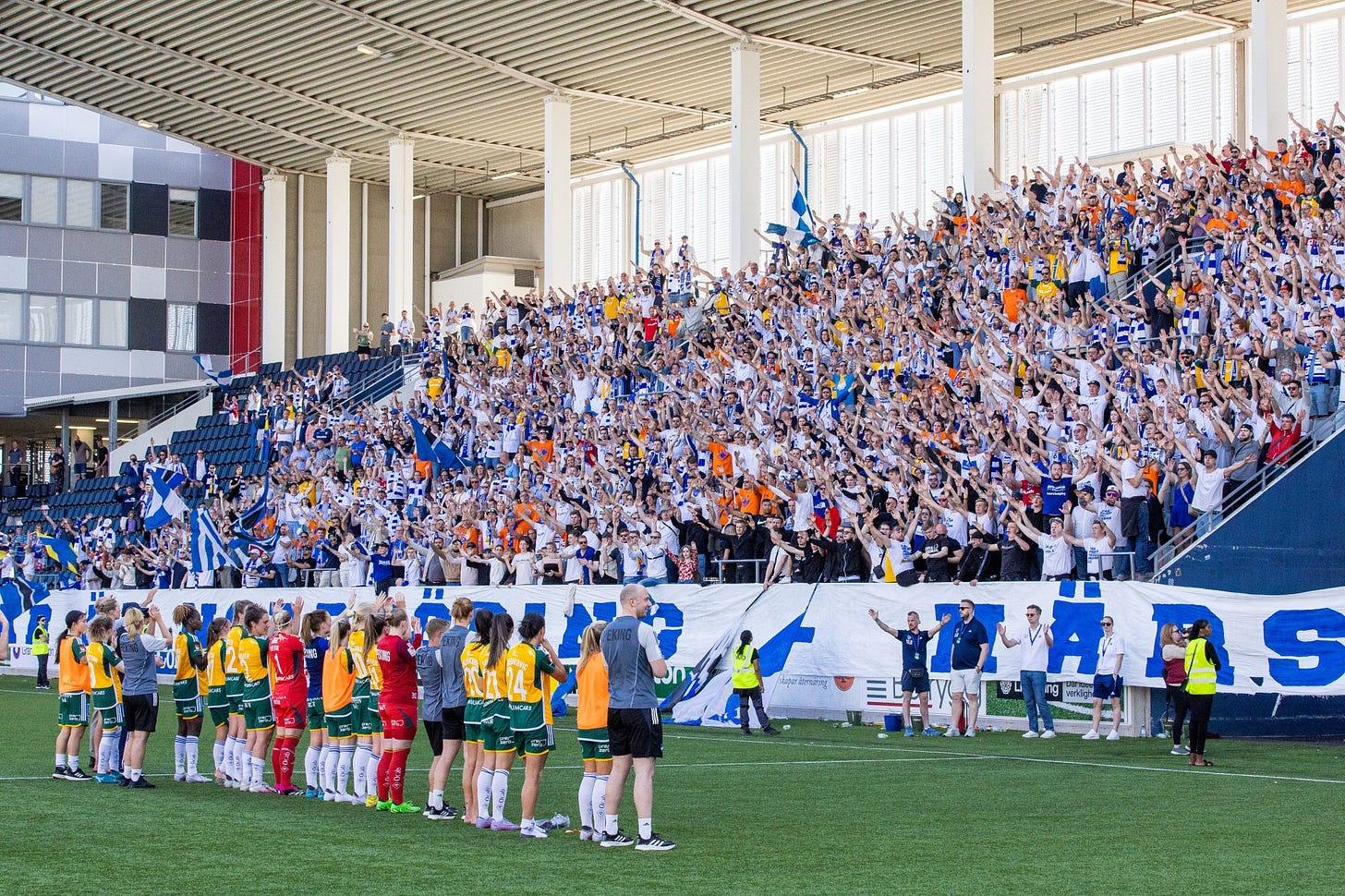ultras = term originated in Italy, way to describe fanatical fans often organised in groups. not to be confused with football hooliganism.
PRO
Having a huge group of people flood the city and clog up the streets before a football game is a sight that is not seen for many other events. The effect of the relentless chanting is hypnotising, combined with the flares and the tangible energy in the air and people are drawn to it like a toddler seeing new colours and shapes for the first time. To see that sizeable inflow for a women’s game is rare, and the effect is discernible. Much like a hype man to a rapper, the supporters bring the VIBES. This is a culture that mainly stems from and exists in men’s football, and a way to get male supporters into the women’s game. It also means more ticket sales and more people in the stands, which in turn brings even more people who are curious about what’s going on.
CON
The cheery atmosphere can turn quite aggressive quite quickly, and when the most part is men, it can feel quite intimidating if you’re not a man.
PRO
These supporters are often very established and have got a lot of experience, and there’s a lot of organisation and money going into these activities. Since the women’s game has a different history (and, let’s be honest, there’s a higher expectation of women taking care of their private life or developing ‘useful’ skills, as opposed to having hobbies like crafting witty banners and buying flares in bulk for football games) that kind of infrastructure is not commonplace yet, especially not ones that are led by women or non-binary people. That is not to say it doesn’t exist however, and groups like Rose City Riveters, supporters of Portland Thorns, are showing how it’s done.
CON
The male supporters come from a game that has a very different history from the women’s game, and has been aimed at a different demographic (well, actually I guess when they put on those ‘show piece’ women’s games in the 1920s it was in order to ridicule the women in front of the men, so in that sense they shared a similar demographic.) The men’s game has a long history of ultras and hooliganism, from the football firms in England to the tifosi in Italy, the ultras in North Africa and the Barras Bravas in South America. Although they bring the amazing art work and an electric atmosphere that can at times make you feel like you’re glued together as one, they also bring a lot of harmful nationalistic rhetoric, violence and chaos in their path.
To illustrate the power of some of these groups: a few days ago, AC Milan’s ultras supporters called the team over after the game that they had just lost 2-0 to Spezia, for a little talking-to. The leader of the ultras is seen screaming at the group of players, which also includes head coach Stefano Pioli. Some people argue that it’s good that the fans get to have a say in their club, whilst others argue that it’s intimidation, and that the motives of these groups are not ones of pure passion.

CON
The women’s game is different because it is a space where there has historically been less men (once they thought they had banned us and left us alone for a minute, that is).
The lack of male presence, and the creation of a space for women where they don’t have to perform solemnly for the male gaze, has opened up for a different way for women to express themselves. One that might embody some of that aggression that is part of the game, but an aggression that does not have to come up against a man’s. Where they don’t have to fight for air in a sea of men, only catching glimpses of other femmes, and where the benchmark is not set by male standards (god knows in our society that is rare).
What I’m wondering is just what the influx of male supporters with ultras vibes is going to do to the match day experience at women’s football. Rather than talk about the absence of men, what I’m trying to get at might be an absence of those male traits and actions that seem to accompany the men (‘not all men’, can be embodied by women as well, but somehow almost always a man). I just think that rather than having women adjusting their behaviour and expectations (as we always do) it’s time for men to adjust and accommodate everyone else.

Granted, this development of male ultras in the women’s game is not going to happen overnight, but as shown at the Östgöta derby between Linköping FC and IFK Norrköping in Sweden this weekend, it’s coming. 7804 supporters showed up to the first top-flight derby between the two cities, where hosts Linköping clinched the three points but Norrköping came with the home support, making up most of the numbers in those stands. The Norrköping support brought banners and flags, amongst them one reportedly depicting a chopped-off lions head, the symbol of Linköping being a lion and a clear signal to the hosts.
Although they’re newcomers to Damallsvenskan, Norrköping have been a positive surprise so far, holding their own on the pitch (currently 8th in the league but having played a lot of the top teams) and the supporters have been turning up.




